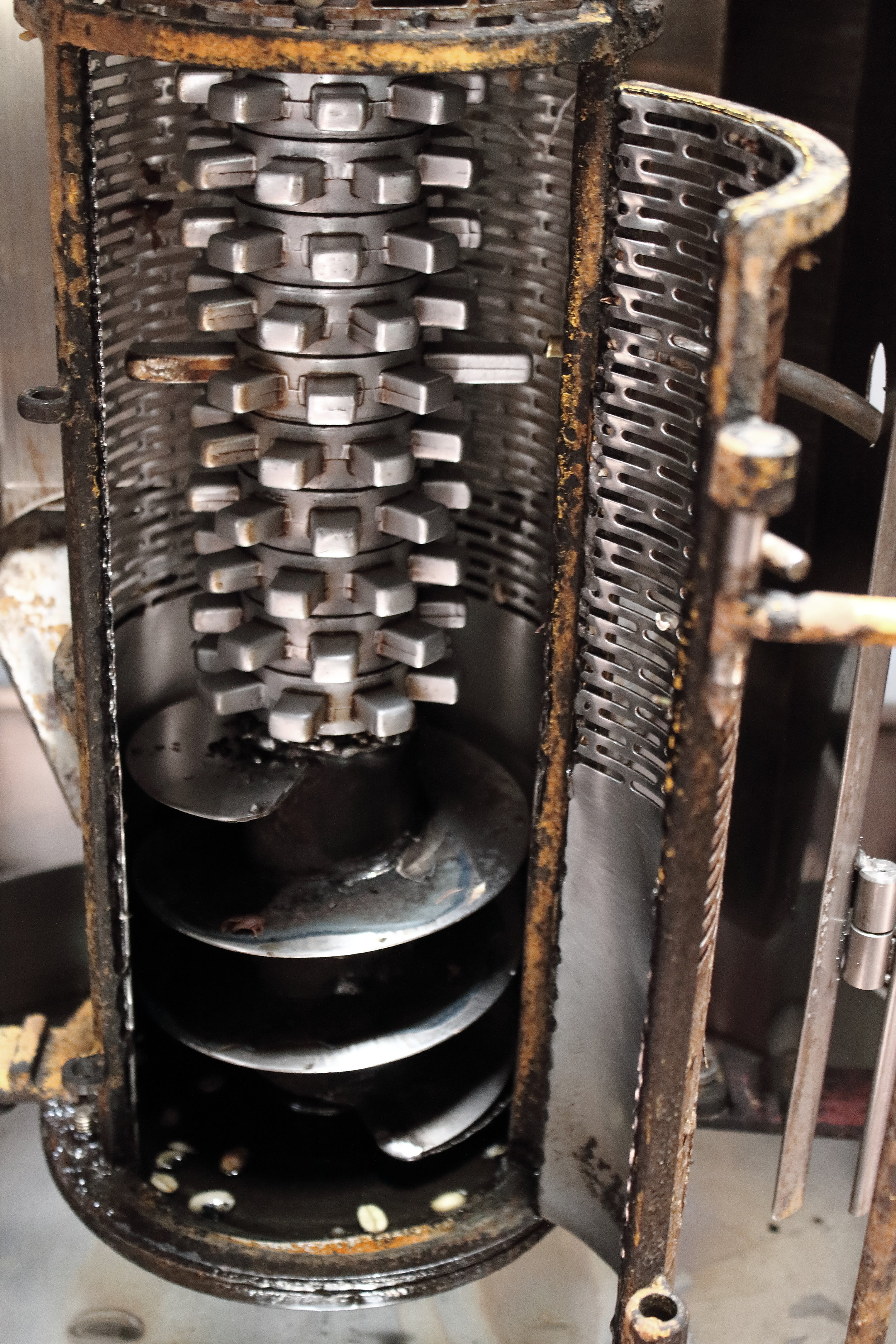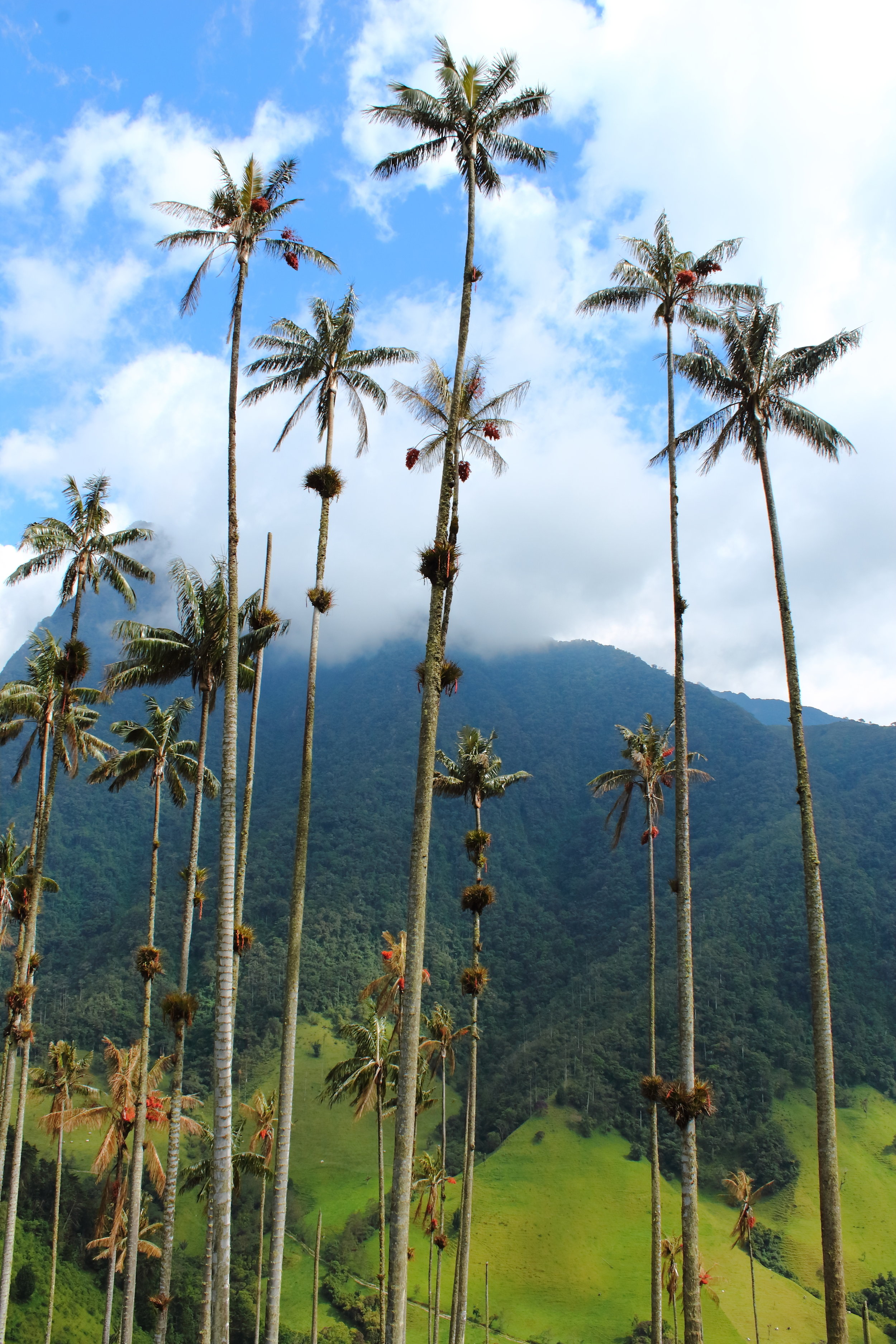Sightseeing in Manizales and Salento
Itinerary: Manizales > Parque Nacional Natural Los Nevados > Hacienda Venecia > Salento > Valle de Cocora
Sights include: another glacier, fields of coffee beans, and the tallest palm tree in the world.
Having gotten my fill of the big cities, I retreated to the countryside to visit the Zona de Cafetera and Valle de Cocora. Little did I know that the university town of Manizales is fairly large and busy, albeit not quite on the same scale as Medellín or Bogotá. Although Manizales has its own attractions — a beautiful cathedral, the obligatory Plaza de Bolívar, and other monuments — I mainly used the city as a jumping-off point for day trips to Los Nevados National Park and a coffee farm.
Similar to El Cocuy, Los Nevados is known for its páramo ecosystem and glaciers (it also includes the Valle de Cocora — more below). From Manizales, you can take a (long) day trip into the park to see the Santa Isabel glacier. The excursion begins with a 4:30 am pickup from your accommodation, starting the 4+ hour drive into the park. I mistakenly thought I might be able to catch some shut-eye on the ride, but the 4x4 trucks are not simply for show — the dirt road proved to be quite bumpy and downright difficult in the especially muddy parts.
The trip includes breakfast and lunch at a remote hostel along the way, which serves as a nice break from the long drive. We arrived at the trailhead just before midday and began the short trek to the glacier; although the hike was not particularly long or strenuous, the altitude presented a formidable challenge for some as it’s a fairly abrupt acclimation coming from Manizales. The weather was also not particularly cooperative, alternating between misty rain and sleety snow at the top. Despite the trail deteriorating into a muddy mess as the day went on, we successfully made it to the glacier for some cloudy pictures and shivers before retracing our steps back to the relative warmth of the vehicles.
Like the glaciers of El Cocuy, Santa Isabel is shrinking, but at a faster rate — the glacier is coated with an ash layer from nearby volcanic activity, preventing it from reflecting some of the sun's energy. Our tour guide demonstrated how the glacier had receded several meters in a matter of months. She also noted that certain plants of the páramo have started to reach higher altitudes, as climate change raises temperatures in the mountains.
The next day, I went the opposite direction, down into the valley below Manizales to Hacienda Venecia for a coffee farm tour and leisurely afternoon on the property. After a chilly day in Los Nevados, I welcomed the warm sunshine and humidity at the hacienda. The tour started in the best way, with a free cup of espresso or coffee. As we sipped our warm beverages, our guide walked us through the coffee process, peppering in fun facts and passing around various beans for smelling and tasting. Although I don’t consider myself a coffee aficionado, I found the session fascinating.
With some fresh knowledge rattling in our heads, we set off on a brief walk around the property, making our way through a field of coffee plants to the sorting and processing facility. One of the things that makes this area of Colombia so unique is that the plants can be harvested year-round; whereas other areas only have an annual or semi-annual harvest, the plants in this coffee sweet-spot produce fruit every 20 days. Pickers must go through by hand, selecting only the ripe fruit, leaving the green ones to mature for the next round of picking.
The afternoon was spent hiking one of the hacienda’s various trails, lounging by the pool, and enjoying the quiet peace of the farm before heading back to the bustle. (For anyone wanting to prolong the tranquility, the hacienda offers an array of accommodation, and the property manager is devoted to providing everyone a pleasant experience — if I did it again, I would definitely stay overnight, but bring bug spray!)
Then onto Salento to hike the famed Cocora Valley, known for the picturesque wax palm, which is tallest palm tree in the world and national tree of Colombia. I spent the first day touring the small, colorful town with beautiful viewpoints of the river valley. I also lucked out with unobstructed, stunning sunset views at my hostel, which was a great end to each day.
To get to the Cocora Valley, you go to the main square in Salento and climb aboard one of the many Willy Jeeps awaiting tourists. Although the paved road would not have presented any difficulties to your standard tour van, I’ll admit I quite liked the somewhat kitschy jeeps. If you’re last to board, you get to stand on the rear bumper which offers a great vantage point but can be pretty wet if it starts to rain.
Upon arriving at the trailhead, you have the option of approaching the hiking loop from either direction, or doing a quick out-and-back up to the most popular point where wax palm trees abound. The loop takes approximately 5 hours at a good pace, but can be stretched into a full day of hiking with viewpoints and rest stops. I was told — and would also recommend — to save the wax palms for the end, so I joined a fellow backpacker on a counter-clockwise loop; you take a right at the blue gate by the Los Nevados National Park sign and enjoy a fairly flat walk through the valley floor before the trail picks up gradient at the tree line. Apparently part of the trail goes through private property, so you have to pay 2 COP for a wristband and access; there will be someone stationed a little ways down the trail to collect the fee.
A number of people opt to ride horses, but I really enjoyed stopping at the small waterfalls along the way and swinging on the rickety hanging bridges that criss-cross the river. There is an observatory/‘casa’ you can hike up to, which costs 5 COP and comes with hot chocolate and cheese — although cheap, the casa is relatively unremarkable, with a few hummingbird feeders and view of trees. For anyone trying to conserve energy, skip the casa and continue onto the most steep part of the trail; when you’ve arrived at the red-roofed rest-stop with beautiful red flowers, you’ve made it to the top! From there, it’s an easy decent through groves of wax palms with valley views.
As I basked in the sun with palms towering overhead, I tried to absorb and fully appreciate all the wonderful experiences I had throughout Colombia. It is a beautiful, varied, welcoming country with a mix of big cities and small pueblos, historic centers and natural wonders, kind locals and like-minded tourists who are undeterred by the safety concerns of just a few years ago. I’m incredibly thankful to have spent a month carving out a loop through the country, getting my first taste of South America (which in Colombia means lots of arepas and almost everything ‘con queso'). I’m excited to carry forward what little Spanish I’ve acquired as I make my way south.
Next Stop: Peru
DETAILS, TIPS & TRICKS
Rome2Rio
Go-to website for researching transit. It’s where I get all the information I need to get from city to city.
Bus from Medellín to Manizales
From the sprawling Medellín Terminal Del Sur (conveniently located near El Poblado, a short Uber away), ask the ticket counters when the next bus to Manizales is leaving (depart every hour or so, 40,000 COP) and jump on board! In my experience, it was just a small van, so be sure to ask the terminal attendants where the bus boards — they may or may not announce departure in the waiting area. Upon arrival in Manizales, you can take the tram to the city center and walk to your accommodation, or jump in the taxi line (~10,000 COP).
Tour to Los Nevados
Most hostels and hotels can organize your tour for you, and many offer discounts — definitely worthwhile to ask! Otherwise, you can reserve via a quick email inquiry; costs 200,000 COP. The two main operators are Kumanday Adventures and Ecosistemas, and they’re basically the same. As in, I booked through one company and was put on a tour with the other.
Bus from Manizales to Salento
Coming from the city center, make your way to the tram, which will drop you off right at the bus terminal. You’ll connect through Pereira, only a short drive from Manizales (11,500 COP about an hour). Then grab one of the frequent buses to Salento (7,500 COP); it will drop you off in the main square, where you can easily walk to your accommodation.
Bus from Salento to Bogotá
I booked my flight to Lima from Bogotá (always important to have a confirmed ticket out of the country when you’re flying internationally), so I spent the good part of the day on a bus back to the big city; some other travelers recommended buying a budget flight from Armenia, but relative to the bus to Cartagena, this bus ride wasn’t bad at all. From Salento, walk to the Armenia bus station (just on the edge of town) and grab a bus to Armenia (pay the 4,500 COP on the bus). Apparently the buses can fill up in the evenings, so it may be best to leave earlier in the day. In Armenia, you’ll find multiple ticket windows selling transit to Bogotá; they should direct you to whichever bus leaves next (46,000 COP). You’ll arrive in Bogotá at the Terminal de Transporte, where you can catch another bus to the city center or jump in a cab. Beware of traffic in the city — it can quickly add to your cab or Uber fare!
Accommodation
Manizales: Golden Frog Mountain Hostel — located just a few blocks from both the Plaza de Bolívar and cathedral, this is a bright, friendly place with spacious rooms, free breakfast, communal kitchen and clean bathrooms. No fancy outlets or night lamps, but large storage lockers. The only trouble is locating the nondescript door on the busy street, but I was lucky to find someone who recognized my backpack and confused look and pointed me in the right direction.
Salento: Luciérnaga Salento Food Drinks Music Hostel — situated on a hill that is a short walk from the main square and is a prime viewpoint for sunsets, this hostel is very professional and books up quickly (not easy to extend your stay). Each room has its own bathroom, and there is a nice restaurant and bar below. No free breakfast, and the kitchen is located in a separate building, but nice if you want to eat out during your stay. Hot showers (yessss); outlets, night lamps, and super comfy comforters for each bunk. Rooms are slightly cramped though with small lockers.































































